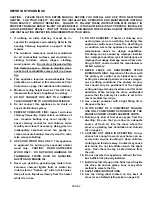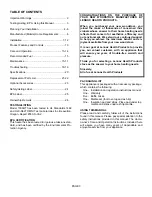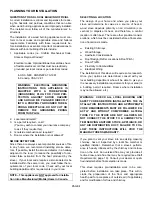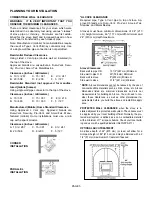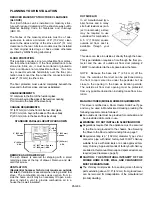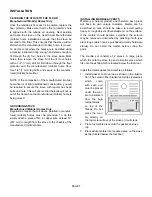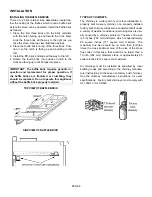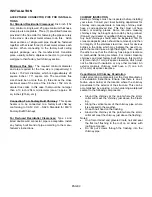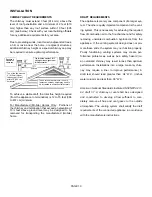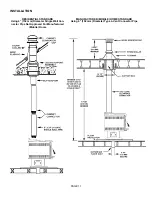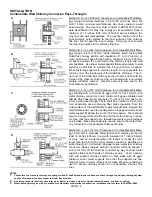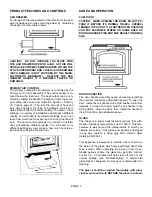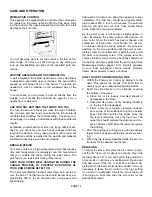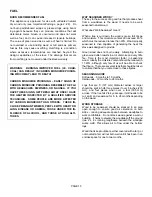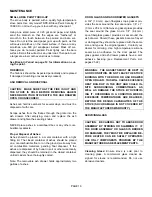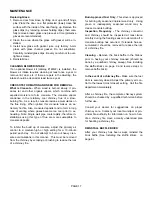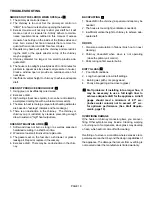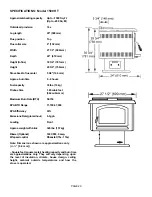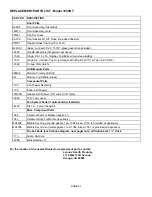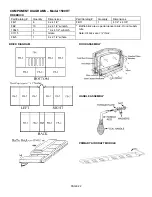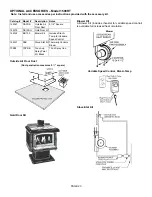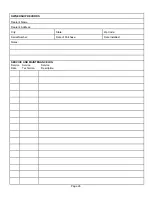
FUEL
PAGE 15
BURN RECOMMENDED FUEL
This appliance is approved for use with untreated natural
dry wood only (see
Important Warnings
, page 2, #8). Do
not burn particleboard scraps or pressed logs using bond-
ing agents because they can produce conditions that will
deteriorate metal. Green or uncured wood does not work
well as fuel, and can cause increased creosote buildups.
The value of green wood as a source of heat is limited. Do
not overload or use kindling wood or mill ends as primary
fuel as this may cause overfiring. Overfiring is a condition
where excessive temperatures are reached, beyond the
design capabilities of the stove. The damage that occurs
from overfiring is not covered under the stove warranty.
WARNING: BURNING IMPROPER FUEL (I.E. CHAR-
COAL) CAN RESULT IN
CARBON MONOXIDE POISON-
ING WHICH MAY LEAD TO DEATH!
CARBON MONOXIDE POISONING – EARLY
SIGNS OF
CARBON MONOXIDE POISONING RESEMBLE THE FLU
WITH HEADACHES, DIZZINESS, OR NAUSEA. IF YOU
HAVE THESE SIGNS, GET FRESH AIR AT ONCE! HAVE
THE HEATER INSPECTED BY A QUALIFIED SERVICE
TECHNICIAN. SOME PEOPLE ARE MORE AFFECTED
BY CARBON MONOXIDE THAN OTHERS. THESE IN-
CLUDE PREGNANT WOMEN, PEOPLE WITH HEART OR
LUNG DISEASE OR ANEMIA, THOSE UNDER THE IN-
FLUENCE OF ALCOHOL, AND THOSE AT HIGH ALTI-
TUDES.
WHY SEASONED WOOD?
The key to the success of a good fire that produces heat
from a woodstove is the wood. It needs to be well-
seasoned natural wood.
What does “Well-Seasoned” mean?
When a tree is cut down, the wood is green, full of sap
and moisture. This moisture content can exceed 80%,
which must be reduced to less than 20%. Wood properly
seasoned is then capable of generating the heat the
stove was designed to provide.
Green wood does not burn easily. Attempting to burn
green wood often results in a lot of smoke and very little
fire. Time is the most important factor in seasoning
wood. Ideally the moisture content should be reduced to
11-20%, although very few of us will be able to check
that figure. There are several steps that should be taken
to ensure that that you come close to these figures.
SEASONING GUIDE
Softwoods – 6 months to 18 months
Hardwoods – 12 months to 24 months
Logs that are 5” (127 mm) diameter across or larger
should be split in half, three pieces if over 8 inches (203
mm), and four pieces when over a foot (305 mm)
across. If the tree fell 2 to 4 years ago, it still needs to be
cut, split, and seasoned for 6 to 24 months depending
on the wood.
WOOD STORAGE
Wood to be seasoned should be stacked in an area
open enough to ensure good air circulation on both
sides – leaving adequate space between woodpiles to
walk comfortable. Do not stack wood against a wall or
building. It helps to elevate the woodpiles off the ground
(two 2 x 4’s running lengthwise beneath the woodpile
works well). This allows air to flow under the bottom
logs.
Wood that is kept outdoors, either covered with a tarp, or
not covered at all, will not burn well until it has been in an
enclose space for one to two months.
Summary of Contents for EARTHSTOVE 1500HT
Page 24: ...SAFETY LISTING LABEL PAGE 24...
Page 25: ...EPA LABEL PAGE 25...


